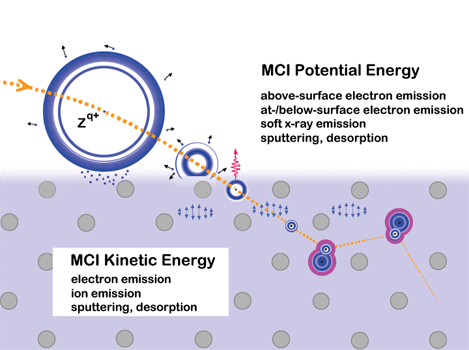MOmentum VEctor Electron Spectroscopy (MOVES) - a novel electron spectrometer
We are designing a novel experimental setup for measuring momentum vectors of electrons being emitted from well defined solid surfaces under the impact of energetic electrons or ions (”MOmentum VEctor Spectroscopy - MOVES”). Single primary particles are applied in short pulses of about 1 ns duration in order to permit coincidence measurements with thereby ejected electrons which are guided from the target surface toward a position-sensitive detector by a weak homogeneous magnetic field (about 1-2mT). As compared to conventional electron spectroscopies, MOVES is able to cover electron emission into the 2π solid angle, to deliver both angular- and energy-dispersive data and to permit, due to multihit-capability of the position-sensitive electron detector, correlation measurements between different ejected electrons. The application of MOVES can deliver pertinent experimental data of rather high quality and thus greatly improve our theoretical understanding of basically interesting and practically important phenomena as secondary electron emission (SEE), ion-induced potential (PE) and - kinetic emission (KE), and the only recently observed excitation of bulk and surface plasmons due to potential ion energy (”potential excitation of plasmons - PEP”).
When slow ions (with kinetic energies of the order of 1keV/amu) are used as projectiles (”ion-induced electron emission”) so called secondary electrons are emitted. In this case the internal degrees of freedom of the projectile may cause a number of additional phenomena since the emission can not only proceed via transfer of kinetic energy (”kinetic emission-KE”) to the solid, but also via potential energy transfer (”potential emission-PE”).
This figure sketches the multitude of processes which are caused by the impact of a slow multiply charged ion (MCI) on a clean metal surface [1]. We can distinguish the ”above-surface” phase which is dominated by hollow-atom formation and -decay, from the subsequent ”at-” and ”below-surface” phases where a close cooperation of potential- and kinetic energy-related effects takes place.

In recent experimental studies [2] it has been demonstrated that PE from the above-surface phase can be distinguished from electron production which takes place lateron at and below the target surface and primarily depends on the kinetic projectile energy involved.
Compared to conventional electron spectroscopy our new method has the following great experimental advantages:
- It involves the event-by-event measurement of the momentum vector of each ejected electron, from which not only their energy distribution as such, but also respective angle-dependent data become available.
- As a counting technique it permits collection of electrons ejected into the full 2π solid angle. In consequence, energy analysis can be achieved with very high transmission (close to unity) and therefore the collection efficiency of the apparatus is by far superior to conventional electron spectroscopy.
- The proposed apparatus will be capable of recording multiple events. In conjunction with the high collection efficiency this makes the method ideally suited for coincidence measurements between primary and secondary electrons as well as for correlated (secondary) emission measurements.
- Registration of the number of ejected electrons for a single projectile impact gives the so–called electron number statistics from which the total electron yield can be directly determined, together with respective angle–dependent data.
- The operating principle of the spectrometer enables for measurement of the lowenergy part of the spectrum with higher energy resolution than with conventional electron spectrometers, this low energy part being of special interest.
- The very effective single particle detection method delivers statistically relevant data also for comparably weak projectile fluxes in a relatively short time during which the status of a well–prepared target surface remains nearly stable. This is of special importance for the investigation of insulating surfaces.
You can get more information about the current development at Smekal's homepage.
[1] A. Arnau, F. Aumayr, P. M. Echenique, M. Grether, W. Heiland, J. Limburg, R. Morgenstern, P. Roncin, S. Schippers, R. Schuch, N. Stolterfoht, P. Varga, et al., Surf. Sci. Reports 229, 1 (1997).
[2] C. Lemell, J. Stöckl, J. Burgdörfer, G. Betz, H. P. Winter, and F. Aumayr, Phys.Rev.Lett. 81, 1965 (1998).
